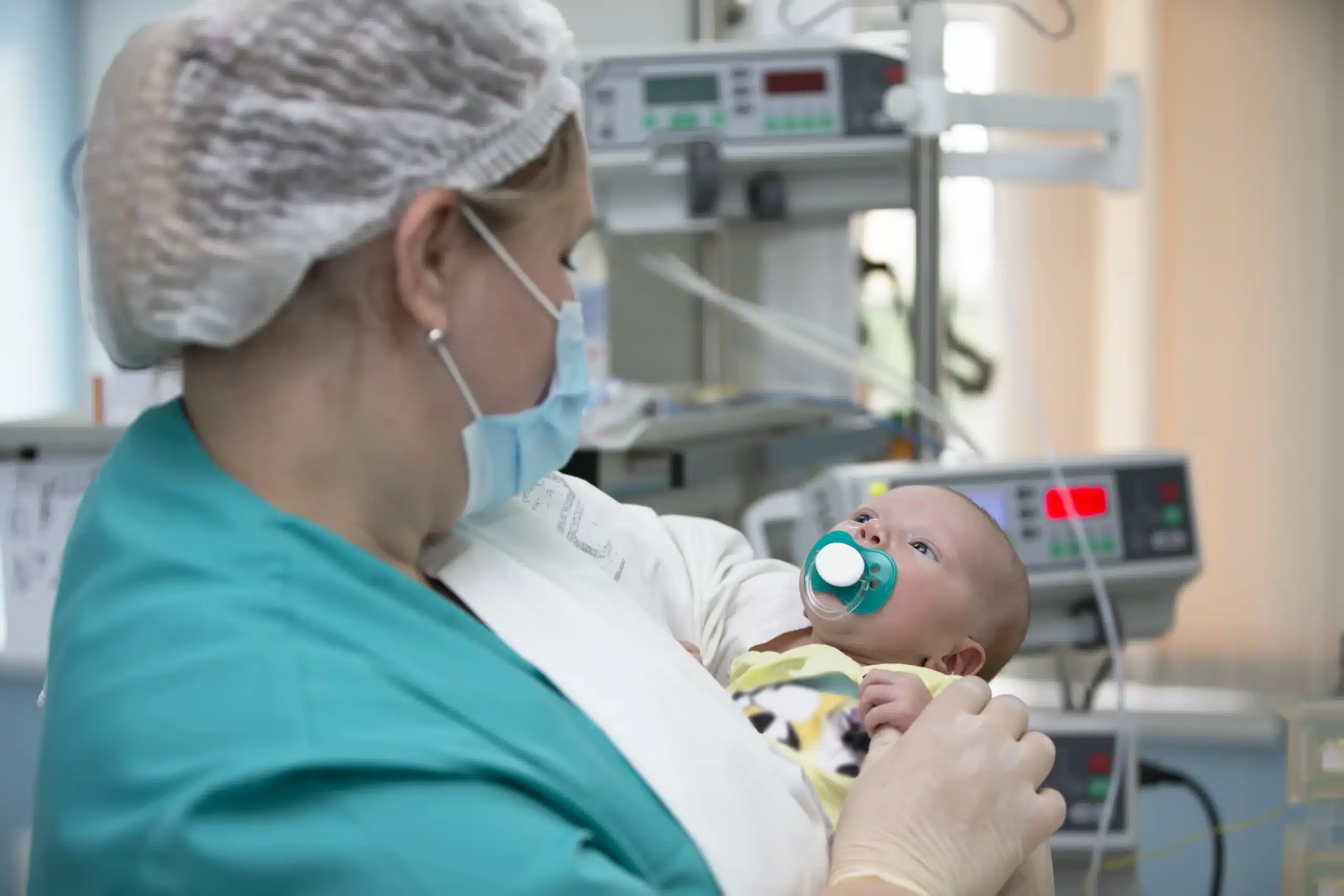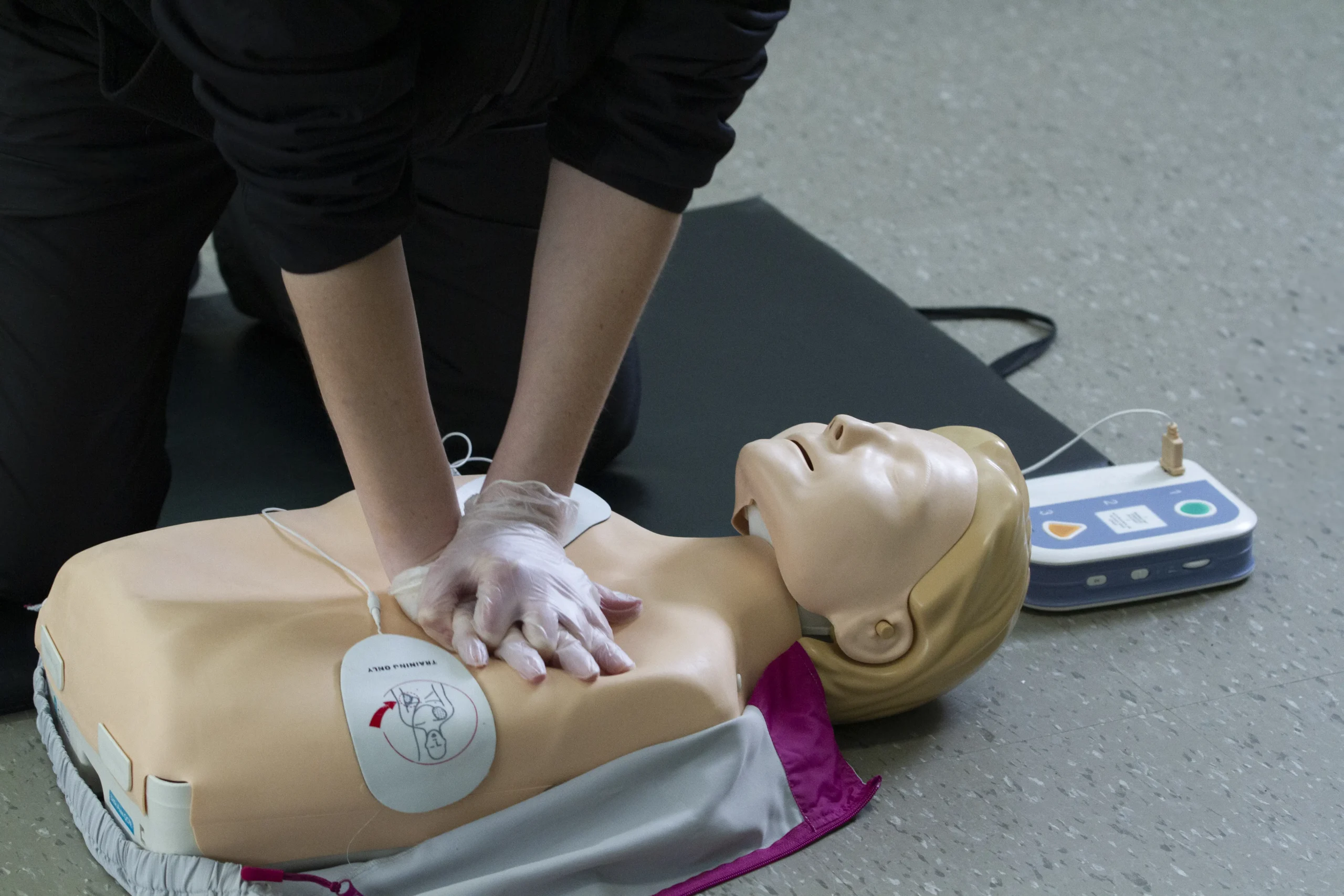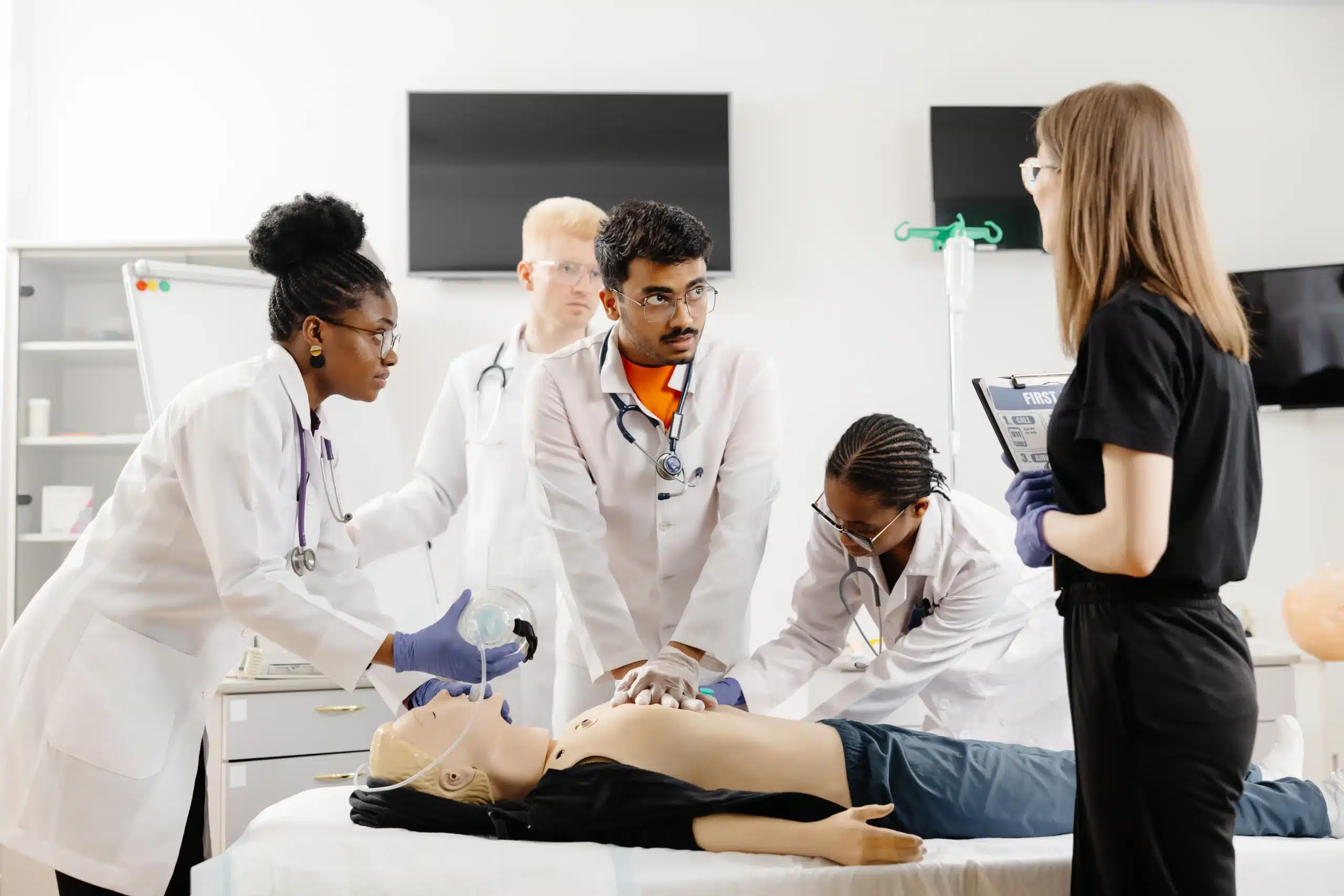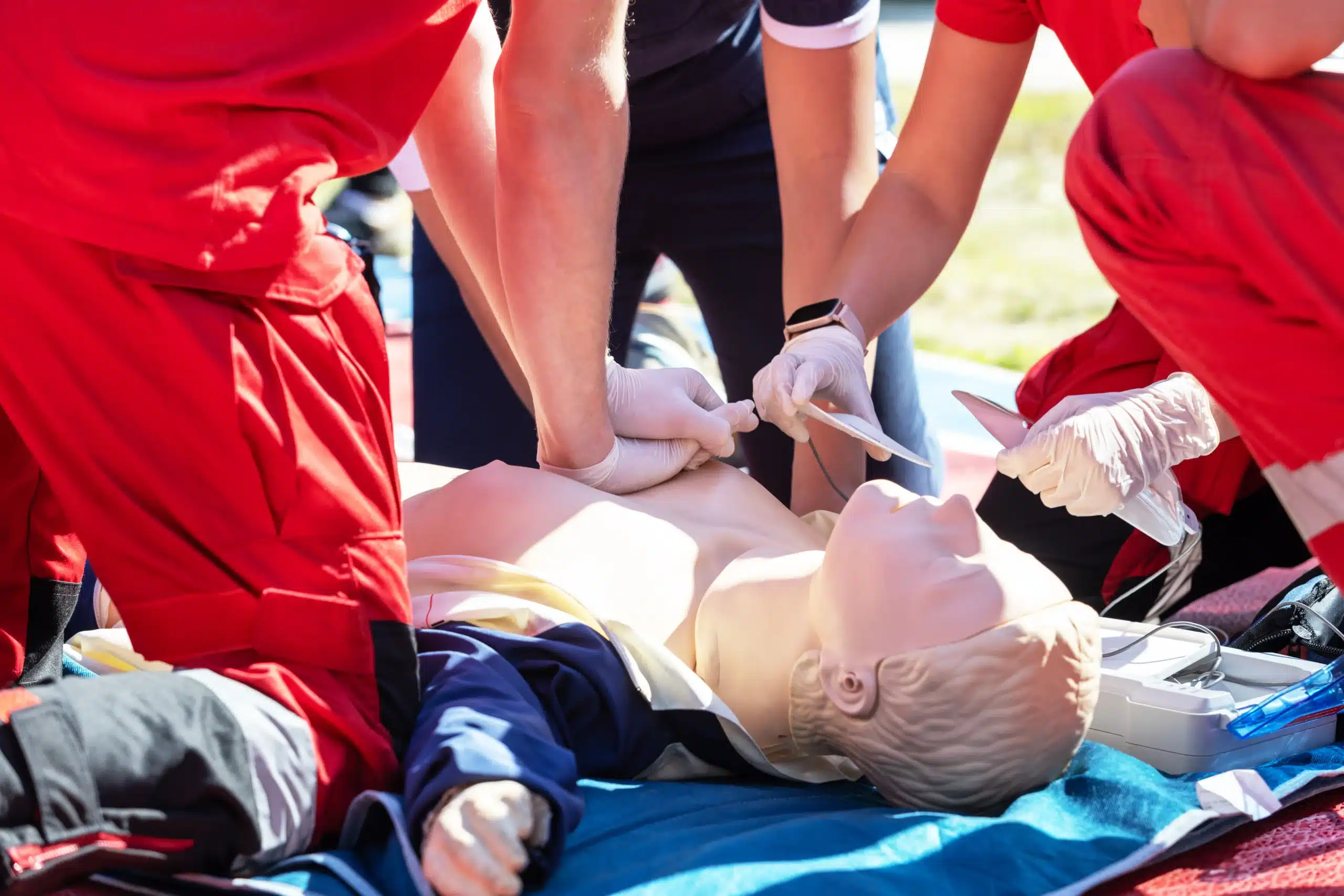Seconds can matter in a medical emergency, especially when a child is involved. Pediatric CPR and first-aid training in Sacramento equips individuals with the skills to respond swiftly and confidently in critical situations. This article delves into the world of pediatric emergency care, highlighting the specific techniques and knowledge required to provide effective assistance to infants and children. We’ll explore the various types of training available in Sacramento, discuss the importance of certification, and offer practical tips for choosing the right course for your needs. We’ll also address common concerns about pediatric CPR and first aid, empowering you to take action when it matters most.
Key Takeaways
- Pediatric CPR and first aid require specific techniques tailored to infants and children. These skills differ from adult CPR and are crucial for responding effectively to emergencies involving young ones. Equipping yourself with this knowledge can make a critical difference in a crisis.
- A range of courses caters to various needs and learning styles. Whether you’re a parent, caregiver, or professional, you can find a course that fits your specific requirements, from basic CPR to comprehensive first-aid training. Consider online and in-person options to match your schedule and preferences.
- Gaining these essential skills is more accessible than you might think. Sacramento offers numerous affordable and convenient training options, including flexible scheduling and competitive pricing. Invest in your family’s safety and well-being by learning these life-saving techniques.
What is Pediatric CPR and First-Aid?
Pediatric CPR and First Aid training gives parents, caregivers, and professionals the skills to handle emergencies involving infants and children. This specialized training focuses on recognizing and responding to medical emergencies specific to younger age groups. It covers a range of situations, from choking and breathing difficulties to allergic reactions and injuries. Learning these skills can empower you to confidently provide immediate care in a crisis, potentially saving a child’s life.
How Does it Differ from Adult CPR?
While the basic principles of CPR remain consistent, there are crucial differences between adult and pediatric CPR. These differences stem from the variations in children’s anatomy and physiology. For infants, CPR involves using two fingers for chest compressions, aiming for a depth of about 1.5 inches, and giving two rescue breaths after every 15 compressions. The techniques for children are slightly different, reflecting their growing bodies. Knowing these distinctions is vital for delivering effective and safe care. Beyond the physical techniques, pediatric CPR also emphasizes emotional support and reassurance for both the child and their caregiver, an aspect not always as prominent in adult CPR training. MyCPR NOW discusses the importance of pediatric first aid.
Debunking Myths About Pediatric Emergency Care
Misconceptions about pediatric emergency care can unfortunately prevent people from taking action when a child needs help. One common fear is that performing CPR incorrectly will harm the child. However, it’s crucial to remember that any attempt at CPR is better than none. Another myth is that CPR for children is the same as for adults. In reality, pediatric CPR techniques are specifically tailored to the physiological differences in children. Simple CPR addresses common CPR misconceptions. Dispelling these myths empowers individuals to act quickly and confidently in emergencies, knowing that their intervention can make a significant difference. Avive AED offers a helpful comparison of infant, child, and adult CPR.
Why is Pediatric CPR and First-Aid Training Important?
Knowing what to do in a medical emergency can make all the difference. Pediatric CPR and first-aid training goes beyond basic first aid, equipping you with the specific skills to respond to emergencies involving infants and children. It empowers you to act quickly and confidently when seconds count.
Advantages for Caregivers and Parents
As a parent or caregiver, the safety and well-being of the children in your care is your top priority. Pediatric first-aid training gives you the skills to handle unexpected situations, from minor injuries like cuts and scrapes to more serious emergencies like choking or allergic reactions. Having this knowledge helps you respond effectively and brings peace of mind. It’s an investment in your family’s safety, allowing you to create a safer environment for the children you love. Online pediatric first-aid courses offer a convenient way to gain these crucial skills. For childcare providers, a comprehensive Pediatric First Aid and CPR certification course can fulfill legal requirements while building confidence in providing a safe and nurturing learning environment.
Essential Skills Across Professions
Pediatric first aid isn’t just for parents and caregivers—it’s a valuable skill set across various professions. Teachers, coaches, camp counselors, and anyone working with children benefit from this specialized training. Children’s bodies react differently than adults’ do, so understanding these differences is crucial for effective emergency care. Pediatric first aid emphasizes emotional support and reassurance, helping to calm and comfort a child during a stressful situation. Whether you’re a healthcare professional needing to know age-specific techniques or a teacher supervising a playground, pediatric first-aid training provides essential skills to keep children safe. The Heartsaver Pediatric First Aid CPR AED course, for example, teaches how to manage illnesses and injuries in children and infants until professional help arrives. If you’re involved in childcare in any capacity, training in pediatric first aid is essential. It equips you with the knowledge and skills to respond confidently and effectively, ensuring the safety and well-being of the children under your care.
Where to Find Pediatric CPR and First-Aid Training in Sacramento
Finding the right pediatric CPR and first-aid training is essential for anyone caring for children. Sacramento offers several reputable training providers with various courses to fit your needs. Here’s a rundown of some popular options:
Safety Training Seminars
Safety Training Seminars offers a range of American Heart Association (AHA) courses, including CPR, BLS, ACLS, PALS, and First Aid certification. Known for their affordability, they offer a low-price guarantee for their Sacramento courses. They also provide an EMSA-approved Child Care Health and Safety course for childcare providers. For those interested in learning more about their pricing, check out their low price guarantee. You can find more information on their first aid training costs in their comprehensive guide.
CPR Certification Sacramento
CPR Certification Sacramento offers combined CPR/AED/First Aid classes, providing comprehensive training. These courses are well-suited for workplace settings and often include instruction on hazard recognition, injury prevention, and emergency protocols.
Hopewell CPR
Hopewell CPR offers the Heartsaver Pediatric First Aid CPR AED course. This classroom-based course meets the 8-hour EMSA childcare training requirement, covering Pediatric First Aid, CPR, and AED use. This AHA-compliant course fulfills part of the EMSA regulatory requirements for childcare providers in California. Visit their website for more information on EMSA requirements.
American Red Cross Sacramento Chapter
The American Red Cross Sacramento Chapter provides in-person first aid certification courses. These courses equip participants with the skills and confidence to respond effectively in emergencies.
Rescue Training Institute
Rescue Training Institute offers first aid, CPR, and AED training specifically for child and infant emergencies. They provide official certification classes at their facility or on-site at workplaces in the Sacramento and Roseville areas.
Which Pediatric CPR and First-Aid Courses Are Available?
Knowing which pediatric CPR and first-aid course best suits your needs can feel overwhelming. This section clarifies the various options available in Sacramento, highlighting what each course covers and who might benefit most. We’ll also look at how these courses align with specific requirements, like those for childcare providers in California.
Infant CPR and Choking Relief
Infant CPR classes equip you to respond to choking and breathing emergencies in babies under one year old. These courses cover rescue breaths, chest compressions, and how to relieve choking. You’ll learn to recognize the signs of a distressed infant and when to call 911. For a comprehensive approach covering infants, children, and adults, CPR Certification Sacramento offers infant CPR classes. This broader training benefits parents, grandparents, and caregivers who want to be prepared for emergencies across age groups.
Child CPR and AED Use
Child CPR courses focus on children over one year old, often including training on using an automated external defibrillator (AED). You’ll learn CPR techniques specific to children, including assessing their condition and delivering appropriate care. The American Red Cross offers an Adult and Pediatric CPR/AED course, combining training for both age groups. This is a practical choice for those wanting a broader skillset applicable to various situations.
Comprehensive Pediatric First-Aid
Beyond CPR, comprehensive pediatric first-aid courses address a wider range of childhood illnesses and injuries. You’ll learn to treat cuts, burns, allergic reactions, and other common pediatric emergencies. These courses often include injury prevention and creating safe environments for children. Hopewell CPR offers Heartsaver Pediatric First Aid CPR AED training that meets California EMSA requirements, a good option for childcare providers needing to fulfill specific licensing obligations.
EMSA-Approved Childcare Provider Training
California childcare providers often require EMSA-approved training. These courses cover pediatric CPR and first aid, often including additional topics like recognizing and responding to child abuse and neglect. The American Heart Association offers a Heartsaver Pediatric First Aid CPR AED course designed for childcare providers to meet these regulatory requirements. This training provides the skills and knowledge to handle emergencies effectively in a childcare setting.
What Happens in a Pediatric CPR and First-Aid Class?
Pediatric CPR and first-aid classes blend hands-on practice with essential knowledge, building your confidence in responding to emergencies involving infants and children. Here’s a glimpse of what you can expect:
Practice Age-Specific Techniques
In a pediatric CPR class, you’ll learn techniques tailored to infants and children, including CPR, choking relief, and recognizing the signs of a medical emergency. Practicing these skills on age-appropriate mannequins prepares you for diverse scenarios. Pediatric first-aid training equips parents and caregivers with essential skills to handle emergencies involving children confidently. Adapting your response to a child’s age is crucial for effective care.
Learn Emergency Recognition and Response
Responding quickly and effectively in the first few minutes of a pediatric emergency is critical. These courses teach you how to assess the situation, determine the best course of action, and provide initial care until professional help arrives. You’ll learn to recognize and manage various illnesses and injuries specific to infants and children, from minor cuts and burns to more serious situations like allergic reactions and breathing difficulties. The American Heart Association offers Heartsaver Pediatric Training with more information on this topic.
Understand Course Duration and Certification
Pediatric first-aid and CPR courses in Sacramento typically last a few hours, varying based on the provider and specific course content. Our first-aid training in Sacramento is priced around $80. Upon completion, you’ll receive a certification card, typically valid for two years, demonstrating your competence in these life-saving skills. For specific course duration and certification details, check with your chosen provider. We also offer a low price guarantee.
How Much Does Pediatric CPR and First-Aid Training Cost?
Compare Prices in Sacramento
CPR and first-aid training are valuable skills, especially for those who care for children. In Sacramento, you can generally find first-aid training for around $80, though prices vary by provider and specific course content. Many providers offer combined CPR/AED/First Aid classes for well-rounded training. At Safety Training Seminars, our low price guarantee reflects our commitment to making these lifesaving skills accessible to everyone.
Weigh Investment and Long-Term Value
Consider pediatric first-aid and CPR training a worthwhile investment. There’s an initial cost, of course, but the skills you learn can be invaluable in an emergency. You’re not simply paying for a certification card (valid for two years); you’re gaining the confidence and know-how to respond effectively when a child needs you. Knowing how to handle breathing emergencies, injuries, and other unexpected events provides invaluable peace of mind. Investing a few hours in learning pediatric first aid is a significant step toward protecting the children you care for.
How Do You Get and Renew Your Certification?
Get Certified
Getting certified in Pediatric CPR and First Aid is straightforward. Several organizations in Sacramento offer comprehensive training. For childcare providers, Hopewell CPR offers Pediatric First Aid CPR AED training that meets California EMSA regulatory requirements. If you’re looking for American Heart Association (AHA) certification, CPR Certification Sacramento provides infant CPR classes covering CPR, AED use, and first aid for infants, children, and adults. The American Red Cross also offers a variety of CPR and AED classes in Sacramento, with in-person, online, and blended learning options. For affordable AHA-certified courses like BLS, ACLS, and PALS, check out Safety Training Seminars, which offers a low-price guarantee.
Renew Your Certification
Most CPR and First Aid certifications are valid for two years. Staying current is crucial, especially when you work with children. Both the American Red Cross and CPR Certification Sacramento emphasize the importance of renewing your certification regularly to maintain your skills. Refresher courses cover the latest techniques and guidelines, ensuring you can respond effectively in emergencies. Contact your certifying organization for specific renewal requirements and available courses. Regularly updating your certification shows your commitment to providing excellent care and preparedness for critical situations.
How Can You Access Training More Easily?
Getting trained in pediatric CPR and first aid should be a straightforward process. Here’s how you can make it even simpler:
Find Flexible Options
Juggling work, family, and other commitments can make scheduling anything feel like a challenge. Luckily, many providers offer flexible options to fit your busy lifestyle. Look for combined CPR/AED/First Aid classes to cover all your bases at once. This comprehensive approach saves you time and ensures you’re prepared for a range of emergencies. Safety Training Seminars offers various American Heart Association (AHA) courses, including CPR, BLS, ACLS, PALS, and First Aid certification, right here in Sacramento.
Address Fears and Anxieties
It’s normal to feel a little apprehensive about learning these skills. Many people worry about performing CPR correctly. Rest assured, hands-on classes use training mannequins so you can practice chest compressions and get comfortable with the techniques. Remember, learning CPR and first aid is an investment in your family’s safety. Even if you never have to use these skills, the peace of mind they provide is invaluable.
Discover Affordable and Accessible Courses
Cost is often a barrier to training, but it doesn’t have to be. You can find affordable first aid training in Sacramento for around $80, sometimes even less depending on the provider and the specific course. Courses like the Heartsaver Pediatric First Aid CPR AED course teach you how to respond to illnesses and injuries in children and infants until professional help arrives. Check with various providers, like Safety Training Seminars, which offers a low price guarantee, to find the best fit for your budget. Don’t let cost prevent you from gaining these essential skills.
How Do You Choose the Right Course?
Choosing the right pediatric CPR and first-aid course depends on several factors, including your specific needs, learning style, and schedule. Let’s break down how to find the perfect fit.
Consider Your Needs
First, think about why you’re taking the course. Are you a parent or grandparent wanting to be prepared for emergencies at home? Are you a childcare provider needing EMSA-approved training? Or are you a healthcare professional requiring certification for your job? Your reason for taking the course will heavily influence which course is right for you.
Many providers offer combined CPR/AED/First Aid classes for comprehensive training. These courses often cover a range of skills, from treating minor injuries to performing life-saving interventions. If you need a broader skillset, a combined CPR/AED/First Aid course might be the most efficient option. For specific professional requirements, like BLS certification, ensure the course aligns with the necessary standards.
Decide Between Online and In-Person Training
Next, consider your learning preferences and schedule. Online courses offer flexibility, allowing you to learn at your own pace. They can be a great option for busy parents or those who prefer self-directed learning. However, in-person training provides hands-on practice with mannequins and instructors, which can be invaluable for building confidence. In-person CPR classes also offer the opportunity to ask questions and interact with other learners. Weigh the pros and cons of each format to determine what suits you best.
Prepare for Your Course and Maintain Your Skills
Finally, think about the long term. Learning pediatric first aid and CPR isn’t a one-time event; it’s an investment. Before your course, familiarize yourself with the course content to maximize your learning. After you’re certified, practice your skills regularly and consider refresher courses to stay sharp. Regular practice will boost your confidence and ensure you’re ready to respond effectively in a real emergency.
Related Articles
- First Aid Training in Roseville: A Complete Guide – Sacramento CPR Classes
- CPR Classes in Sacramento: The Complete Guide – Sacramento CPR Classes
- Debunking 10 CPR Myths You Need to Know – Sacramento CPR
- Essential CPR & First-Aid Training for Safer Workplaces
- CPR & First-aid Classes in Sacramento, CA – Sacramento CPR Classes
Frequently Asked Questions
Is pediatric CPR drastically different from adult CPR?
Pediatric CPR shares the same core principles as adult CPR, but there are key differences in technique due to a child’s smaller size and developing anatomy. These differences include the force used for chest compressions, hand placement, and the depth of compressions. It’s essential to learn these specific techniques to provide safe and effective care to an infant or child.
What if I’m too afraid to perform CPR on a child?
It’s completely understandable to feel hesitant about performing CPR, especially on a child. However, remember that doing something is always better than doing nothing in an emergency. Training courses offer a safe environment to practice on mannequins, which helps build confidence and reduces anxiety. The knowledge that you’re equipped to help can empower you to act quickly and decisively when it matters most.
Which pediatric CPR and first-aid course is best for me?
The ideal course depends on your individual needs. Parents and caregivers might choose a basic course covering common childhood emergencies. Childcare providers often require specific certifications, such as those meeting California’s EMSA standards. Healthcare professionals typically need more advanced training. Consider your specific circumstances and choose a course that aligns with your goals.
Are online pediatric first-aid and CPR courses as effective as in-person classes?
Online courses offer flexibility and convenience, making them a great option for busy schedules. However, in-person classes provide hands-on practice and direct interaction with instructors, which can be beneficial for developing confidence and mastering techniques. Consider your learning style and preferences when deciding which format is best for you.
How can I find affordable pediatric CPR and first-aid training in Sacramento?
Several organizations in Sacramento offer affordable training options. Look for providers like Safety Training Seminars, which offers a low-price guarantee. Comparing prices and course content from different providers can help you find a course that fits both your budget and your learning needs. Don’t let cost be a barrier to gaining these essential life-saving skills.








